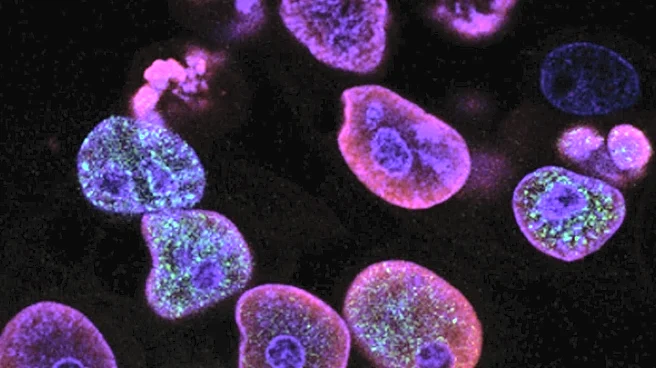What's Happening?
Hair thinning is a common concern affecting over 50% of women in their lifetime, according to experts. Dermatologists have identified several causes, including physiological and emotional stress, hair damage, underlying health conditions, genetics, hormonal changes, and habits like hair pulling. Stress can lead to telogen effluvium, a condition where hair shifts from the growth phase to the resting phase, causing rapid hair loss. Hair damage from over-processing and tight hairstyles can result in traction alopecia. Health conditions like anemia, thyroid disorders, and autoimmune diseases such as alopecia areata and lichen planopilaris can also contribute to hair loss. Genetic predispositions can lead to androgenetic alopecia, the most common form of hair thinning in women. Hormonal changes during pregnancy, menopause, and conditions like PCOS can affect hair health. Dermatologists recommend various treatments, including topical and oral minoxidil, platelet-rich fibrin matrix treatment, and micro-grafting, to manage hair thinning.
Why It's Important?
Understanding the causes of hair thinning is crucial for effective management and treatment. Hair loss can significantly impact self-esteem and mental health, making it essential to address underlying issues. The identification of stress, health conditions, and genetic factors as contributors to hair thinning allows for targeted interventions. Treatments like minoxidil and platelet-rich fibrin matrix offer hope for those affected, potentially improving hair density and quality. Early intervention is key, as it can prevent irreversible damage and promote healthier hair growth. The availability of diverse treatment options reflects advancements in dermatology, providing individuals with more choices to manage their condition.
What's Next?
Individuals experiencing hair thinning are encouraged to consult dermatologists for personalized treatment plans. Lifestyle changes, such as a balanced diet and stress management, can support hair health. Regular health screenings can identify underlying conditions contributing to hair loss. Dermatologists may recommend topical treatments like minoxidil or explore advanced options like micro-grafting for severe cases. Continued research into the causes and treatments of hair thinning will likely lead to more effective solutions. Public awareness campaigns can educate individuals on the importance of early intervention and available treatments.
Beyond the Headlines
Hair thinning can have cultural and social implications, affecting personal identity and self-expression. The stigma associated with hair loss may deter individuals from seeking help, highlighting the need for supportive communities and resources. Ethical considerations arise in the marketing of hair loss treatments, emphasizing the importance of evidence-based claims. Long-term shifts in dermatology may focus on preventive measures and holistic approaches to hair health, integrating mental wellness and lifestyle factors.











